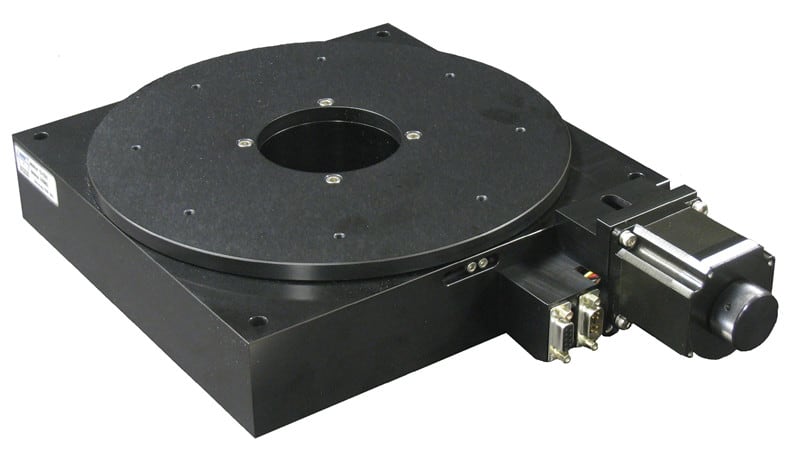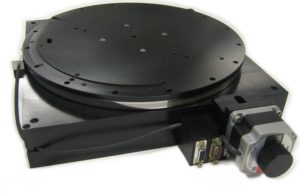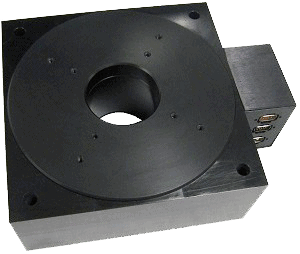Motorized Rotation Stages
A motorized rotation stage is an advanced positioning device that achieves precise rotational movement around a central axis, often incorporating an open aperture for optical pathways or mounting flexibility, and leveraging high-performance motor systems like stepper, DC, or direct-drive motors to enable smooth, controlled motion. Common applications include life science and diagnostics, such as imaging system alignment, rotational positioning for DNA sequencing, sample manipulation in microscopy and spectroscopy. Explore Dover Motion’s motorized rotation stages below.
Motorized Rotation Stage Products
The RTR™ series motorized rotation stages are available in multiple diameters and use a precision worm gear drive for stiff angular positioning and are suitable when the payload is offset.
| wdt_ID | Travel | 360 degrees |
|---|---|---|
| 1 | Accuracy | 0.05 degree |
| 2 | Repeatability | 0.005 degree |
| 3 | Payload | 45 kg |
The DRT-100 and DRT-200 are ultra-compact, direct-drive rotary stages recommended for applications requiring the highest speed and precision.
| wdt_ID | Travel | 360 degrees |
|---|---|---|
| 1 | Accuracy | +/- 150 urad |
| 2 | Repeatability | +/- 5 urad |
| 3 | Payload | 100 kg |
Why Choose Dover Motion for Motorized Rotation Stages?
At Dover Motion, we specialize in providing advanced motion control solutions that excel in performance, reliability, and adaptability. Our motorized rotation stages have the following features:
- High Precision: Achieve angular accuracy up to ±0.05 degree and repeatability as fine as ±0.005 degree.
- Durable Design: Featuring rigid crossed roller bearings and anti-backlash mechanisms for consistent performance.
- Wide Payload Range: Our stages can handle payloads from delicate samples to heavy components, up to 100 kg.
- Compact Direct Drive Options: For applications where space and speed are critical, our ultra-compact direct drive stages deliver both.
- Custom Solutions: Work with our engineers to design motorized rotation stages tailored to your project requirements.
FAQ
A motorized rotation stage, also known as a rotary stage, is a precision positioning device that provides accurate rotational movement around a single axis. Powered by various electric motors, these stages facilitate automated and programmable motion, essential for applications demanding high accuracy.
A motorized rotation stage functions by transforming electrical energy into mechanical rotational motion. It typically consists of the following components:
- Motor: Drives the rotation of the mounted platform.
- Bearing System: Supports the platform, ensuring smooth and low-friction movement. Common types include crossed roller and air bearings.
- Encoder: Provides real-time feedback on the platform's angular position, enabling precise control.
- Control System: Allows for programmable motion profiles, automated positioning sequences, and repeatable accuracy.
Precision in rotation is defined by three key parameters:
- Accuracy: How closely the stage's actual position aligns with the commanded position.
- Repeatability: The stage's ability to consistently return to the same position across multiple movements.
- Resolution: The smallest increment of rotation that the stage can reliably achieve.
- Precision Lapped Worms and Worm Gears: Driven by stepper or servo motors, these stages are suitable for stiff angular positioning at low to medium speeds, especially when the payload is offset.
- Direct Drive Systems: Ideal for applications requiring the highest speeds and precision.
Motorized rotation stages play a critical role in many life science and diagnostic applications, enabling precise and repeatable positioning. They are widely used in the following areas:
- Microscopy:
- Live Cell Imaging: Precisely rotating samples under a microscope allows for observation of cellular processes from multiple angles, providing valuable insights into cell behavior, morphology, and interactions.
- Fluorescence Microscopy: Accurate rotation is essential for optimizing image acquisition in fluorescence microscopy techniques, such as FRET (Fluorescence Resonance Energy Transfer) and FRAP (Fluorescence Recovery After Photobleaching), where precise positioning of excitation and observation points is crucial.
- Cell Sorting and Analysis:
- Flow Cytometry: Rotation stages can be integrated into flow cytometry systems to orient cells for analysis, allowing for more accurate measurements of cell size, shape, and internal structures.
- Cell Separation: Precise rotation can be used to manipulate cell orientation for separation techniques, such as dielectrophoresis, where cell orientation significantly influences separation efficiency.
- Drug Discovery and Development:
- High-Throughput Screening: In drug discovery, rotation stages can be used to precisely position compounds for screening against target proteins, enabling high-throughput analysis and accelerating the drug development process.
- Patch-Clamp Electrophysiology: Accurate rotation is essential for positioning electrodes in patch-clamp experiments, allowing for precise measurements of ion channel activity in individual cells.
- Biomedical Imaging:
- Computed Tomography (CT) and Magnetic Resonance Imaging (MRI): Rotation stages are integral to CT and MRI systems, enabling the acquisition of images from multiple angles, which are then reconstructed into 3D images of the internal structures of the body.
- Positron Emission Tomography (PET): Precise rotation of the patient or the detector is essential for accurate image acquisition in PET imaging, allowing for the localization and quantification of radioactive tracers in the body.



